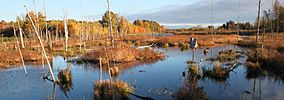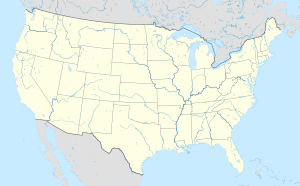Missisquoi National Wildlife Refuge facts for kids
Quick facts for kids Missisquoi National Wildlife Refuge |
|
|---|---|
|
IUCN Category IV (Habitat/Species Management Area)
|
|
 |
|
| Location | Franklin County, Vermont, United States |
| Nearest city | Swanton, Vermont |
| Area | 7,232 acres (29.27 km2) |
| Established | 1943 |
| Governing body | U.S. Fish and Wildlife Service |
| Website | Missisquoi National Wildlife Refuge |
| Official name: Missisquoi Delta and Bay Wetlands | |
| Designated: | 20 November 2013 |
| Reference #: | 2200 |
The Missisquoi National Wildlife Refuge is a special place in Vermont where wild animals and plants are protected. It's located on the eastern side of Lake Champlain, close to the border with Canada. This refuge is the only one of its kind completely in Vermont. It's managed by the United States Fish and Wildlife Service, which helps take care of wildlife across the country.
The refuge was started on February 4, 1943. It began with about 1,582 acres (6.4 square kilometers) of land. This included areas around the Missisquoi River delta, like Shad Island. Over time, more land has been added from people who wanted to sell it. Today, the refuge is much larger, covering 7,232 acres (about 27 square kilometers). It stretches across the towns of Swanton and Highgate.
Contents
Protecting Different Habitats
The refuge has many different types of natural areas. These include forests that flood, wet marshy lands, bushy areas, bogs, open grassy fields, and higher dry lands. All these different habitats help support a wide variety of wildlife.
Managing Land for Wildlife
The main goal of the refuge is to protect homes for birds that travel long distances. It also aims to keep all the natural plants and animals diverse and plentiful. The refuge helps animals and plants that are in danger of disappearing. Rules about wildlife are followed to make sure the habitats and animals stay safe.
Maquam Bog: A Special Wetland
Maquam Bog is a unique wetland area within the refuge. It covers about 900 acres. This bog is home to Vermont's largest groups of pitch pine trees. You can also find rhodora plants and chain ferns here. Chain ferns are a species that is threatened in Vermont. The bog is an important place for white-tailed deer in winter. Many birds also use it for feeding and raising their young.
Forest Management for Birds
Some forest areas are carefully cut down in small sections every 8 to 10 years. This helps create different ages of trees. This is important for birds like the woodcock. Small clearings, usually 100 feet wide, provide places for them to feed, nest, and raise their chicks. Open grassy areas next to these clearings are kept mowed. These spots are used by woodcock for singing and resting. Many animals, including woodcock, ruffed grouse, turkey, deer, and songbirds, need forests that are disturbed sometimes. This helps new, dense trees grow, which supports woodcock populations.
Keeping Grasslands Open
Grassy fields are also managed. They are sometimes hayed, mowed, or even burned. This stops them from turning back into forests. Many animals benefit from these open fields. Waterfowl, bobolinks, and other songbirds use them for nesting. Small mammals and insects also live here. Birds of prey, like kestrels, northern harriers, and rough-legged hawks, hunt over these grasslands. They look for small animals like mice.
Managed Wetlands for Waterfowl
Besides 5,000 acres of natural marsh, the refuge has 1,200 acres of wetlands that are managed by people. These are made by three special water areas. The water levels in these areas are changed on purpose. This helps plants that waterfowl eat, like wild rice, to grow. It also creates dry spots for birds like mallards and American black ducks to build their nests.
Amazing Animals!
The Missisquoi Refuge is home to many different animals. It's a very important place for them to live and thrive.
Bird Life and Reproduction
Historically, Shad Island in the refuge was home to Vermont's largest group of great blue herons. These birds build their nests together in a "rookery." The number of nests changes each year, from about 250 to almost 600. Recently, the number of nests has gone down. This might be because there are more bald eagles in the area.
Every fall, more than 20,000 ducks gather at the refuge. They find places to feed and rest here. In the spring, some of these ducks stay to nest and raise their young. All of Vermont's endangered black terns nest at the refuge. A large number of Vermont's nesting ospreys also make their homes here.
Other Wildlife
Spiny soft-shell turtles, which are a threatened species in Vermont, use the refuge. They feed and warm themselves in the sun from April through September. Many different mammals also live in the refuge. These include raccoons, black bears, coyotes, skunks, beavers, red foxes, river otters, bobcats, porcupines, muskrats, and minks.


